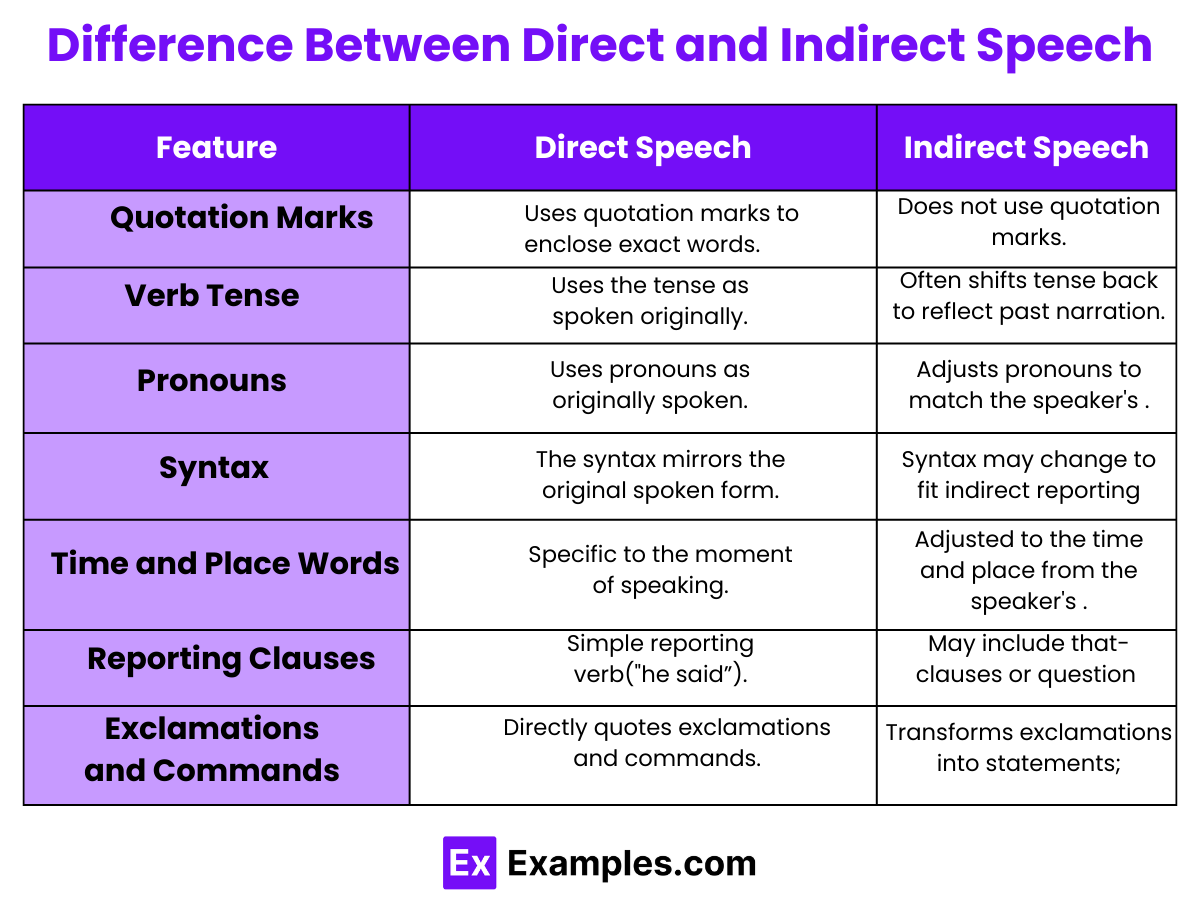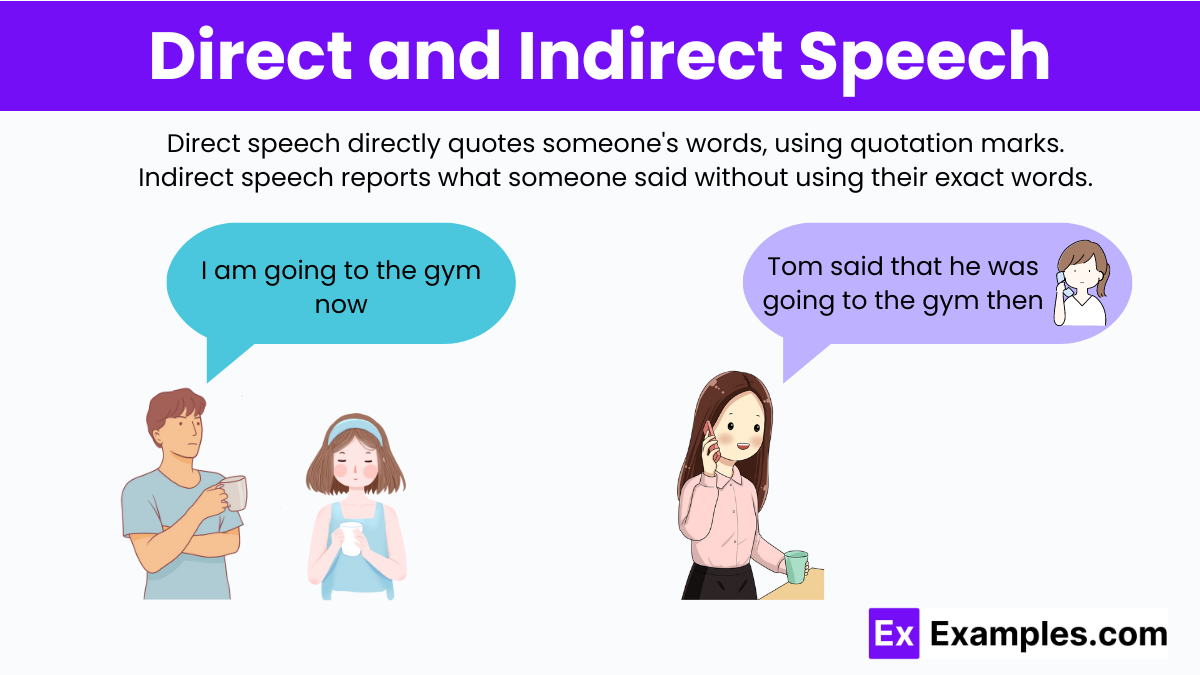Direct and Indirect Speech – Definition, Examples, Differences
Direct and Indirect Speech: Direct speech quotes the exact words spoken, using quotation marks, while indirect speech paraphrases the spoken words without quotes, often changing tenses and pronouns. Both forms are essential for effective communication, emphasizing clarity and context in reporting speech.
What is Direct Speech?
Direct speech refers to the exact words spoken by someone, presented within quotation marks and often accompanied by a speech tag that attributes the statement to the speaker. This method of reporting speech is used to convey the original words and the tone in which they were spoken, preserving the personal touch and specific expressions of the speaker.
For example, if John says, “I am going to the store,” the direct speech presentation would be:
John said, “I am going to the store.”
What is Indirect Speech?
Indirect speech, also known as reported speech, is a method of conveying what someone said without quoting their exact words. Instead of using direct quotations, indirect speech summarizes or paraphrases the original statement. It often involves changes in verbs tenses, pronouns, and other elements to fit the grammatical context of the reporting sentence.
For example, consider the direct speech statement:
Tom said, “I am going to the gym now.”
When converted into indirect speech, it becomes:
Tom said that he was going to the gym then.
Indirect speech does not use quotation marks and typically introduces the reported clause with conjunctions like “that,” although “that” can be omitted in informal contexts.
Rules of Direct and Indirect Speech
Rules for converting Direct into Indirect speech
- Change in Pronoun: Pronouns are often changed in indirect speech to match the perspective of the speaker.
- Example: Direct: He said, “I am tired.”
- Indirect: He said that he was tired.
- Change in Tense: The tense usually shifts back in time in indirect speech.
- Example: Direct: She says, “I am reading a book.”
- Indirect: She says that she is reading a book. (Note: When reporting in the present tense, as with ‘says’, the tense may not always change.)
- Change in Time and Place Words: Words that indicate time and place change to fit the perspective of the speaker.
- Example: Direct: “I will go there tomorrow,” John said.
- Indirect: John said that he would go there the next day.
- Change in Modal Verbs: Modal verbs can change in indirect speech, such as ‘will’ to ‘would’ and ‘can’ to ‘could’.
- Example: Direct: She said, “I can solve the problem.”
- Indirect: She said that she could solve the problem.
- Question Form: Questions in direct speech are often introduced by a conjunction like ‘if’ or ‘whether’ and the verb comes after the subject in indirect speech.
- Example: Direct: He asked, “Are you coming?”
- Indirect: He asked if I was coming.
- Imperatives: Commands, requests, and advice in direct speech are usually converted into infinitive forms.
- Example: Direct: He said, “Close the door.”
- Indirect: He asked me to close the door.
- Exclamations and Wishes: Exclamatory sentences are turned into statements.
- Example: Direct: She said, “What a beautiful day!”
- Indirect: She exclaimed that it was a beautiful day.
Rules for converting Indirect Speech into Direct Speech
- Change in Pronoun: Adjust pronouns to match the speaker’s original perspective.
- Example: Indirect: He said that he was tired.
- Direct: He said, “I am tired.”
- Tense Restoration: Restore the verb tense to the original as spoken by the speaker in direct speech.
- Example: Indirect: She says that she is reading a book.
- Direct: She says, “I am reading a book.” (Note: Sometimes the tense doesn’t need to change if the reporting verb is in the present tense.)
- Time and Place Words: Convert words that indicate time and place back to their original context.
- Example: Indirect: John said that he would go there the next day.
- Direct: John said, “I will go there tomorrow.”
- Modal Verbs: Change modal verbs back to their original forms, if they were altered.
- Example: Indirect: She said that she could solve the problem.
- Direct: She said, “I can solve the problem.”
- Question Form: If the indirect speech is a reported question, it should be converted back into the original question format.
- Example: Indirect: He asked if I was coming.
- Direct: He asked, “Are you coming?”
- Imperatives: Convert instructions or requests back into direct commands.
- Example: Indirect: He asked me to close the door.
- Direct: He said, “Close the door.”
- Exclamations and Wishes: Turn statements of exclamation or wishes back into their original exclamatory form.
- Example: Indirect: She exclaimed that it was a beautiful day.
- Direct: She said, “What a beautiful day!”
Difference Between Direct and Indirect Speech

| Feature | Direct Speech | Indirect Speech |
|---|---|---|
| Quotation Marks | Uses quotation marks to enclose exact words. | Does not use quotation marks. |
| Verb Tense | Uses the tense as spoken originally. | Often shifts tense back to reflect past narration. |
| Pronouns | Uses pronouns as originally spoken. | Adjusts pronouns to match the speaker’s perspective. |
| Syntax | The syntax mirrors the original spoken form. | Syntax may change to fit indirect reporting (e.g., question forms are changed). |
| Time and Place Words | Specific to the moment of speaking. | Adjusted to the time and place from the speaker’s perspective. |
| Reporting Clauses | Simple reporting verb (“he said,” “she said”). | May include that-clauses or question words (if, whether). |
| Exclamations and Commands | Directly quotes exclamations and commands. | Transforms exclamations into statements; commands into requests with infinitive verbs. |
This table should help you clearly see how the format, verbs, pronouns, and other elements differ between direct and indirect speech.
Direct and Indirect Speech Examples
1. Direct: “I love reading books,” Jane said.
Indirect: Jane said that she loved reading books.
2.Direct: “We will go to the park,” they announced.
Indirect: They announced that they would go to the park.
3.Direct: “I have finished my homework,” he told his mother.
Indirect: He told his mother that he had finished his homework.
4.Direct: “Can you help me with this?” she asked.
Indirect: She asked if I could help her with that.
5.Direct: “I am feeling sick today,” he whispered.
Indirect: He whispered that he was feeling sick that day.
6.Direct: “I won’t be able to attend the meeting,” Laura said.
Indirect: Laura said that she would not be able to attend the meeting.
7.Direct: “Please open the window,” she requested.
Indirect: She requested him to open the window.
8.Direct: “Do not touch my phone,” he warned.
Indirect: He warned not to touch his phone.
9.Direct: “I’ll call you tomorrow,” she promised.
Indirect: She promised that she would call me the next day.
10.Direct: “What time does the concert start?” he asked.
Indirect: He asked what time the concert started.
Examples of Direct and Indirect Speech Exercises with Answers
Direct to Indirect Speech Exercises
Convert the following sentences from direct to indirect speech:
Exercise 1 : “I am learning to play the piano,” she said.
Answer 1: How did she say she was learning to play the piano?
Exercise 2: “Will you be attending the meeting?” he asked me.
Answer 2: How did he ask if I would be attending the meeting?
Exercise 3: “I have seen that movie three times,” Alex told her.
Answer 3: How did Alex tell her that he had seen that movie three times?
Exercise 4 : “You should try the new Italian restaurant,” he recommended.
Answer 4: How did he recommend trying the new Italian restaurant?
Exercise 5 : “Please pass the salt,” she requested.
Answer 5: How did she request to pass the salt?
Exercise 6: “I cannot come to your party,” Jane apologized.
Answer 6: How did Jane apologize that she could not come to the party?
Exercise 7 “Let’s meet at the mall,” they suggested.
Answer 7: How did they suggest meeting at the mall?
Exercise 8: “Do you know where the station is?” he inquired.
Answer 8: How did he inquire if I knew where the station was?
Exercise 9: “I must finish this book tonight,” she declared.
Answer 9: How did she declare that she must finish the book that night?
Exercise 10: “I didn’t take your notebook,” he denied.
Answer 10: How did he deny taking my notebook?
Indirect to Direct Speech Exercises
Convert the following sentences from indirect to direct speech:
Exercise 11: She said that she was learning to play the piano.
Answer 11: What did she say about learning to play the piano in direct speech?
Exercise 12: He asked if I would be attending the meeting.
Answer 12: How did he ask about my attendance at the meeting in direct speech?
Exercise 13: Alex told her that he had seen that movie three times.
Answer 13: What did Alex tell her about how many times he had seen the movie in direct speech?
Exercise 14: He recommended trying the new Italian restaurant.
Answer 14: What did he say about trying the new Italian restaurant in direct speech?
Exercise 15: She requested to pass the salt.
Answer 15: What did she request about the salt in direct speech?
Exercise 16: Jane apologized that she could not come to the party.
Answer 16: What did Jane say when she apologized for not coming to the party in direct speech?
Exercise 17: They suggested meeting at the mall.
Answer 17: What did they suggest about meeting in direct speech?
Exercise 18: He inquired if I knew where the station was.
Answer 18: How did he inquire about the location of the station in direct speech?
Exercise 19: She declared that she must finish the book that night.
Answer 19: What did she declare about finishing the book in direct speech?
Exercise 20: He denied taking my notebook.
Answer 20: What did he say when he denied taking the notebook in direct speech?
FAQ’s
How do tenses change in indirect speech?
Tenses in indirect speech usually shift back (e.g., present to past) to reflect that the speaking occurred in the past.
Do pronouns always change in indirect speech?
Pronouns change in indirect speech to match the perspective of the speaker reporting the speech, ensuring clarity and coherence.
How do you convert a question from direct to indirect speech?
Questions in direct speech are converted by introducing a clause with ‘if’ or ‘whether’, and rearranging the syntax to statement form.
What happens to modal verbs in indirect speech?
Modal verbs often change in indirect speech, with ‘will’ becoming ‘would’ and ‘can’ changing to ‘could’, for example.
Can the verb tense remain the same in indirect speech?
Yes, if the reporting verb is in the present tense, the tense within the reported clause might not change.
What are the typical introductory verbs used in indirect speech?
Common verbs include ‘said’, ‘told’, ‘asked’, ‘replied’, ‘exclaimed’, and ‘advised’, depending on the nature of the speech.
How do you handle imperatives in indirect speech?
Imperatives are converted into infinitive structures, such as changing “Close the door” to “He asked her to close the door.”



